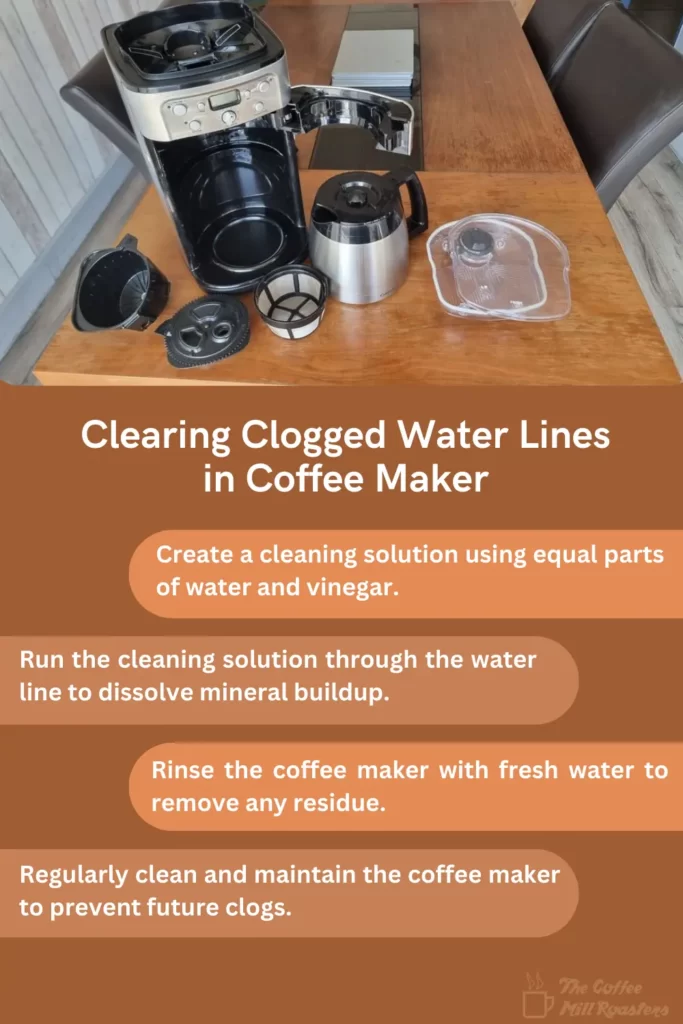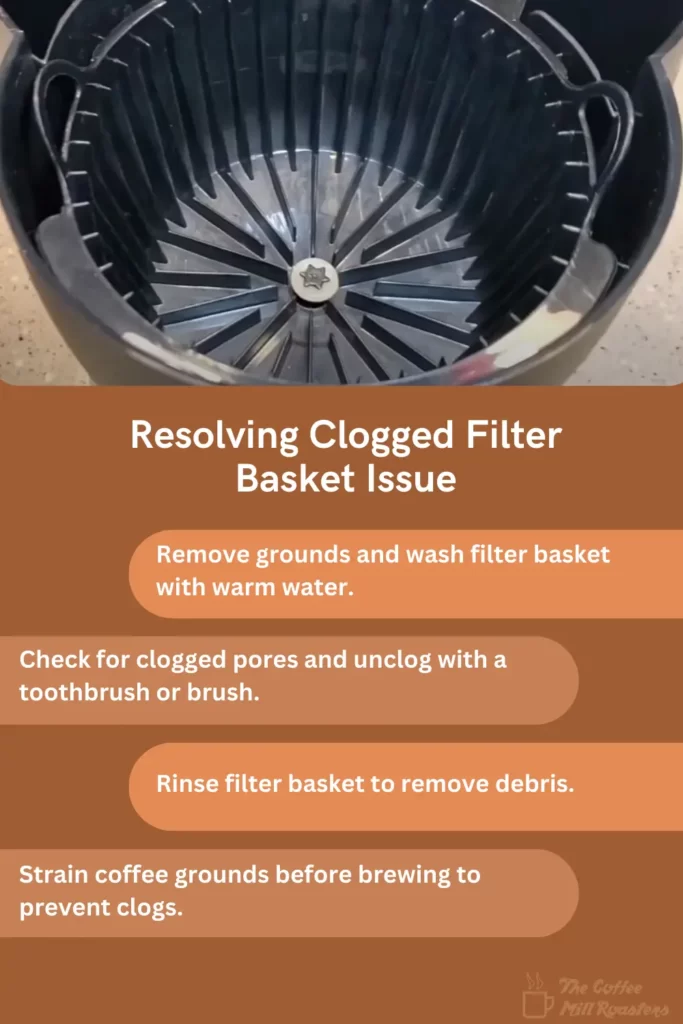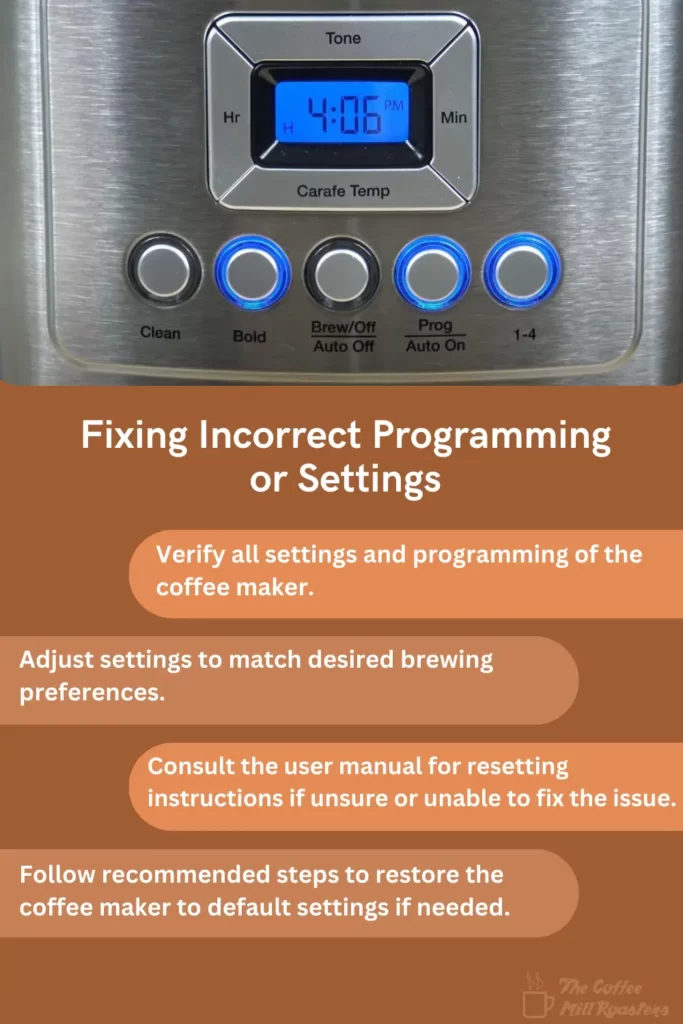Your Cuisinart coffee maker may not brew coffee because of clogging in internal components, leakage, malfunctioning heating elements and inaccurate brewing settings.
In this post, we will share some essential troubleshooting relevant to these issues so you can fix them at home.
Read and explore.
Cuisinart Coffee Maker Turns On But Doesn’t Brew
Though your Cuisinart coffee maker seems active and well-conditioned, it may not brew coffee because of several internal issues. Here are some of them and their possible solutions.
1. Clogged Water Lines
A jammed water line is one of the most common issues interrupting in brewing coffee. When the line gets clogged, your coffee machine can brew slower and incompletely, even cannot brew at all. The common reasons behind the issue are mineral buildup, improper cleaning and poor maintenance.
How to fix:
You can make a cleaning solution with 1:1 part of water and vinegar and run the liquid through the line. The mixture will dissolve any mineral buildup inside the water line.

Find more about Troubleshooting a Cuisinart Coffee Maker
2. Malfunctioning Heating Elements
The heating element, the coil, is responsible for making the water hot to the correct temperature for brewing. Due to electrical problems, physical damage and age, it can malfunction. As a result, the heating element will prevent the water from reaching the optimal temperature and stop the brewing cycle.
How to fix:
Unfortunately, a damaged or malfunctioning heating element is irreparable. If you notice that the coil is not generating the required heat, you may need to replace it.
Fixing Tips: Why Is My Cuisinart Coffee Maker Not Pumping Water?
3. Faulty Valves
A faulty valve can prevent water from flowing properly through the coffee machine. Since it restrains water from going into the brewing chamber, you may notice slow brewing, overflowing, or even no brewing. Coffee machine valves can be damaged because of mineral buildup or wear and tear from regular use.
How to fix:
In such a case, you should descale your Cuisinart coffee maker to remove any limescale buildup. If the valve is permanently clogged or seriously damaged, you must replace it.
Fixing Tips: Cuisinart Coffee Makers’ Error Codes
4. Clogged Filter Basket
Due to leftover coffee grounds, mineral buildup and debris, the pores of a filter basker can be jammed. Thus, the water will not be able to pass through the coffee grounds and the basket, which can stop the coffee maker from brewing.
How to fix:
Running warm water through the basket and brushing out the remaining ground can fix the issue immediately. However, if the basket is extensively dirty, you can scrub it with a soft brush or sponge. In the case of mineral buildup, soak the basket in a mixture of warm water and white vinegar.

5. Insufficient Water In The Water Tank
If the water tank of your Cuisinart coffee maker is not filled well, the machine may fail to draw enough water through the system and properly brew coffee. Insufficient water seems to be a simple issue. But it can damage your machine’s heating element and other components.
How to fix:
Always fill the water tank with fresh and clean water up to the maximum filling line before brewing.
6. Dirty Water Filter
Many coffee enthusiasts use water filters in coffee machines designed to remove impurities from the water used to brew coffee. But if the filter becomes extremely dirty, it can prevent the water flow. So, you may experience weak coffee or no brewing at all.
How to fix:
You should remove the dirty water filter from the Cuisinart coffee maker and place a new one.
7. Water Leaking from the Reservoir or Other Parts
Water leaking can drain out the coffee machine’s tank silently and causes water insufficiency. This issue will prevent optimal brewing and even impact the machine’s performance and lifespan.
How to fix:
In such a case, you must identify the source of the leakage. Generally, a faulty seal or gasket cause the problem. If you find such a defective part, replace it immediately. Also, ensure that your coffee machine is properly assembled.
8. Incorrect Programming or Settings
Cuisinart coffee makers are equipped with various programs and settings. These customizable options are very helpful for users to adjust the strength, volume and other characteristics of brewing. But if any settings are set incorrectly or not programmed accurately, the machine may not perform your desired brewing.
How to fix:
Double-check the settings and programming of the coffee maker if you have faced any issues before. If you cannot fix the problem or are unsure of detecting the actual issue, reset your coffee maker following its user manual.

9. Malfunctioning Power Switch
A defective power switch will provide no power to the coffee maker. Therefore, the machine will not turn on and brew coffee.
How to fix:
Notice carefully whether the switch is loose or disconnected. In these cases, you may need to replace it with a new one. However, sometimes, a defective power switch with no physical damage is repairable.
Frequently Asked Questions
Yes, it does. Water with high mineral content, also called hard water, can form mineral buildup inside the coffee machine and damage its components gradually.
Using filtered water to brew coffee is a good idea to prevent mineral buildup inside a coffee maker. Also, regular descaling is highly recommended to remove any mineral formation.
It depends on the type of filter you use and the level of impurities in the water. For example, charcoal water filters for coffee makers need to be replaced every two months.
You can increase the coffee maker’s lifespan by using filtered water for brewing, regular descaling and proper maintenance. Also, if you can identify any dangerous issue, take the coffee maker to a technician before it becomes the worst.